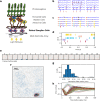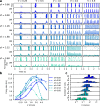Speed-Selectivity in Retinal Ganglion Cells is Sharpened by Broad Spatial Frequency, Naturalistic Stimuli
- PMID: 30679564
- PMCID: PMC6345785
- DOI: 10.1038/s41598-018-36861-8
Speed-Selectivity in Retinal Ganglion Cells is Sharpened by Broad Spatial Frequency, Naturalistic Stimuli
Abstract
Motion detection represents one of the critical tasks of the visual system and has motivated a large body of research. However, it remains unclear precisely why the response of retinal ganglion cells (RGCs) to simple artificial stimuli does not predict their response to complex, naturalistic stimuli. To explore this topic, we use Motion Clouds (MC), which are synthetic textures that preserve properties of natural images and are merely parameterized, in particular by modulating the spatiotemporal spectrum complexity of the stimulus by adjusting the frequency bandwidths. By stimulating the retina of the diurnal rodent, Octodon degus with MC we show that the RGCs respond to increasingly complex stimuli by narrowing their adjustment curves in response to movement. At the level of the population, complex stimuli produce a sparser code while preserving movement information; therefore, the stimuli are encoded more efficiently. Interestingly, these properties were observed throughout different populations of RGCs. Thus, our results reveal that the response at the level of RGCs is modulated by the naturalness of the stimulus - in particular for motion - which suggests that the tuning to the statistics of natural images already emerges at the level of the retina.
Conflict of interest statement
The authors declare no competing interests.
Figures








Similar articles
-
Fidelity of the ensemble code for visual motion in primate retina.J Neurophysiol. 2005 Jul;94(1):119-35. doi: 10.1152/jn.01175.2004. Epub 2004 Dec 29. J Neurophysiol. 2005. PMID: 15625091
-
Three Small-Receptive-Field Ganglion Cells in the Mouse Retina Are Distinctly Tuned to Size, Speed, and Object Motion.J Neurosci. 2017 Jan 18;37(3):610-625. doi: 10.1523/JNEUROSCI.2804-16.2016. J Neurosci. 2017. PMID: 28100743 Free PMC article.
-
Simulated Saccadic Stimuli Suppress ON-Type Direction-Selective Retinal Ganglion Cells via Glycinergic Inhibition.J Neurosci. 2019 May 29;39(22):4312-4322. doi: 10.1523/JNEUROSCI.3066-18.2019. Epub 2019 Mar 29. J Neurosci. 2019. PMID: 30926751 Free PMC article.
-
Cellular mechanisms for direction selectivity in the retina.Neuron. 2007 Jul 19;55(2):179-86. doi: 10.1016/j.neuron.2007.07.001. Neuron. 2007. PMID: 17640521 Review.
-
Neural Mechanisms of Motion Processing in the Mammalian Retina.Annu Rev Vis Sci. 2018 Sep 15;4:165-192. doi: 10.1146/annurev-vision-091517-034048. Epub 2018 Aug 10. Annu Rev Vis Sci. 2018. PMID: 30095374 Review.
Cited by
-
Cortical recurrence supports resilience to sensory variance in the primary visual cortex.Commun Biol. 2023 Jun 23;6(1):667. doi: 10.1038/s42003-023-05042-3. Commun Biol. 2023. PMID: 37353519 Free PMC article.
-
Predictive Visual Motion Extrapolation Emerges Spontaneously and without Supervision at Each Layer of a Hierarchical Neural Network with Spike-Timing-Dependent Plasticity.J Neurosci. 2021 May 19;41(20):4428-4438. doi: 10.1523/JNEUROSCI.2017-20.2021. Epub 2021 Apr 22. J Neurosci. 2021. PMID: 33888603 Free PMC article.
-
Overcoming the limitations of motion sensor models by considering dendritic computations.Sci Rep. 2025 Mar 17;15(1):9213. doi: 10.1038/s41598-025-90095-z. Sci Rep. 2025. PMID: 40097493 Free PMC article.
-
Unfolded protein response IRE1/XBP1 signaling is required for healthy mammalian brain aging.EMBO J. 2022 Nov 17;41(22):e111952. doi: 10.15252/embj.2022111952. Epub 2022 Oct 31. EMBO J. 2022. PMID: 36314651 Free PMC article.
-
Learning heterogeneous delays in a layer of spiking neurons for fast motion detection.Biol Cybern. 2023 Oct;117(4-5):373-387. doi: 10.1007/s00422-023-00975-8. Epub 2023 Sep 11. Biol Cybern. 2023. PMID: 37695359
References
-
- Vaney, D. I., Sivyer, B. & Taylor, W. R. Direction selectivity in the retina: symmetry and asymmetry in structure and function. Nature Reviews Neuroscience 1–15 (2012). - PubMed
Publication types
MeSH terms
LinkOut - more resources
Full Text Sources

